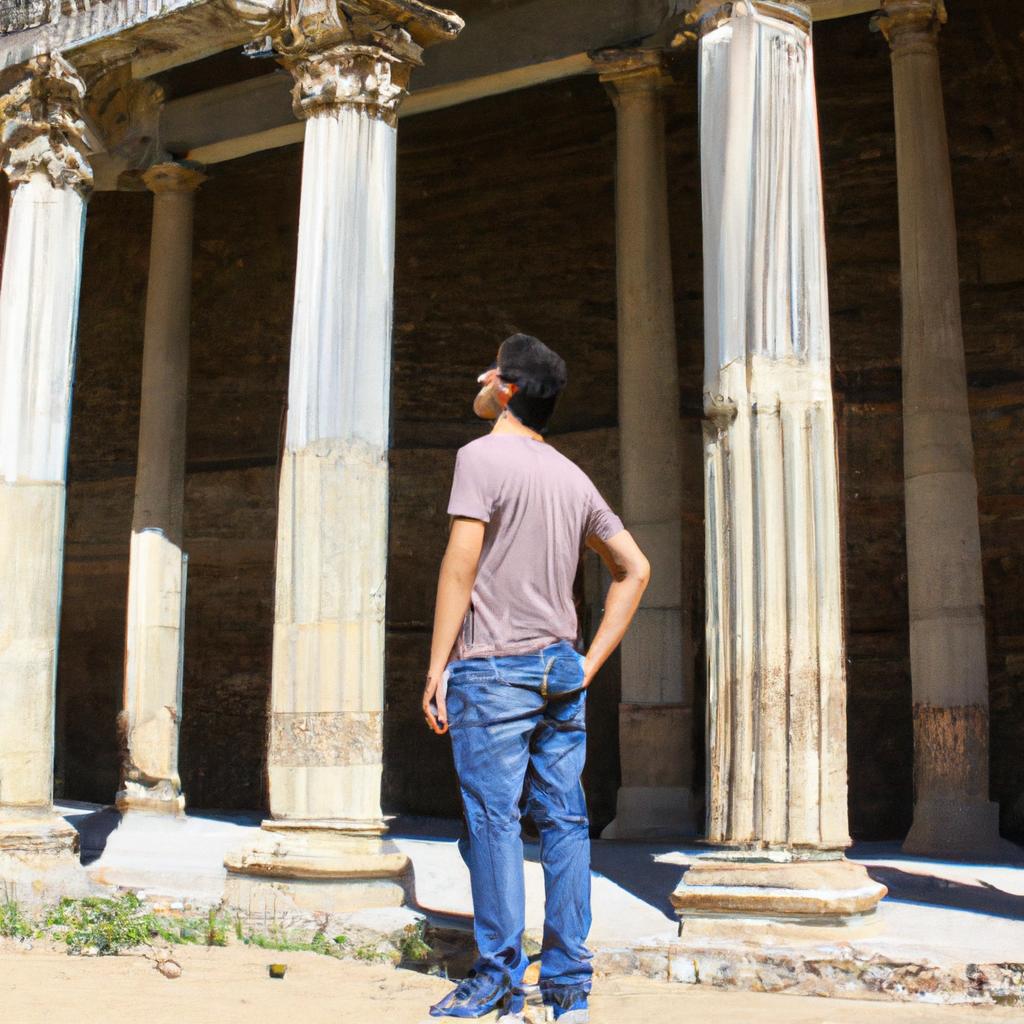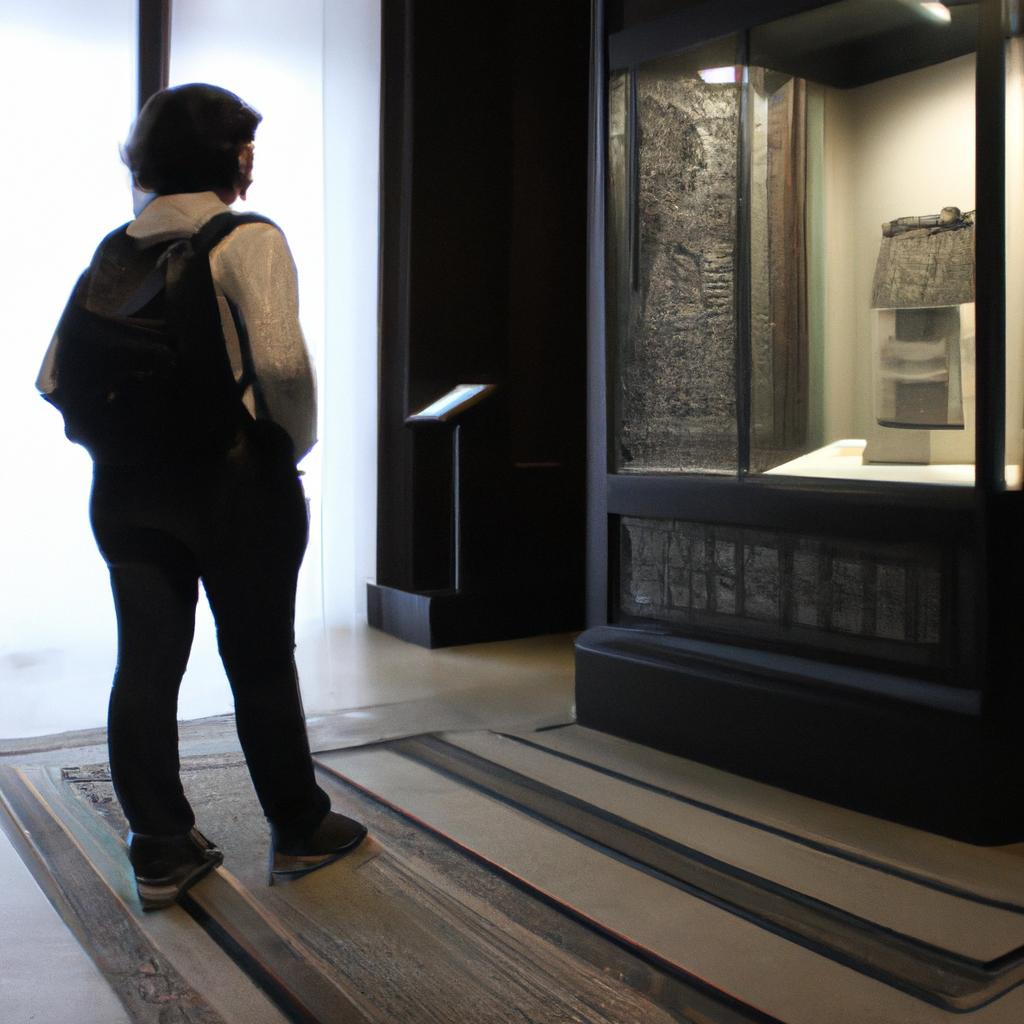Indigenous history and cultural heritage in North America encompass a rich tapestry of traditions, experiences, and knowledge that have shaped the continent for centuries. Exploring this vibrant aspect of our collective past not only invites us to appreciate the diverse cultures that thrive on these lands but also provides an opportunity to challenge dominant narratives and foster deeper understanding. For instance, imagine embarking on a journey across the vast landscapes of Canada’s Yukon territory, where you encounter the Tr’ondëk Hwëch’in First Nation. Through engaging with their ancestral stories, art forms, and traditional practices such as fishing and hunting, one gains insights into their profound connection to nature and holistic way of life.
The significance of Indigenous history and cultural heritage lies not only in its potential to captivate travelers with its uniqueness but also in its power to dismantle stereotypes and promote inclusivity. By delving into the past struggles faced by Native communities in reclaiming their identities amidst colonization, we can begin to grasp the resilience demonstrated by these groups throughout time. Moreover, immersing oneself in Indigenous cultures while traveling fosters intercultural dialogue, mutual respect, and appreciation for alternative ways of being in the world. It is through acknowledging the contributions made by Indigenous peoples that we can truly It is through acknowledging the contributions made by Indigenous peoples that we can truly honor their history, protect their cultural heritage, and work towards a more equitable and inclusive future.
Pre-colonial indigenous cultures in North America
Pre-colonial Indigenous Cultures in North America
Imagine a vast and diverse continent, where vibrant civilizations flourished long before the arrival of European settlers. One such example is the Ancestral Puebloans, who inhabited the southwestern region of what is now known as the United States. These indigenous peoples left behind intricate cliff dwellings and awe-inspiring pottery, providing us with glimpses into their rich cultural heritage.
The pre-colonial era in North America was characterized by the presence of numerous indigenous cultures, each with its distinct traditions, languages, and societal structures. From the Inuit communities residing in the Arctic to the Navajo tribes inhabiting the Great Plains, these native groups cultivated deep connections with their land and developed sophisticated systems for survival.
To gain a deeper understanding of the complexity and diversity of pre-colonial indigenous cultures in North America:
- Spirituality: Indigenous societies held profound spiritual beliefs that influenced every aspect of their lives. Their reverence for nature fostered environmentally sustainable practices and an interconnectedness between humans and their surroundings.
- Artistic Expression: Native American art encompassed various forms, including intricate carvings, storytelling through petroglyphs, exquisite beadwork, and ceremonial regalia adorned with symbolic motifs representing ancestral wisdom.
- Traditional Knowledge: Indigenous communities possessed extensive knowledge about medicinal plants, hunting techniques, agriculture methods suited to local environments, astronomical observations for navigation purposes—knowledge passed down from generation to generation.
- Communal Living: Collaboration played a pivotal role within indigenous societies. The concept of communal living emphasized shared responsibilities and collective decision-making processes.
| Pre-Colonial Indigenous Cultures | |
|---|---|
| Rich Diversity | Vast array of languages spoken |
| Sustainable | Environmental practices |
| Artistic | Diverse artistic expressions |
As we delve further into our exploration of North America’s history, it becomes evident that the impact of colonization on indigenous communities was profound. The arrival of European settlers brought about significant changes in land ownership, cultural assimilation efforts, and political upheavals. Nonetheless, the resilience and perseverance exhibited by these native societies continue to shape North America’s modern landscape.
Transitioning into the subsequent section: ‘Impact of Colonization on Indigenous Communities’
Impact of colonization on indigenous communities
Pre-colonial indigenous cultures in North America were diverse and rich, encompassing a wide range of traditions, languages, and beliefs. These cultures flourished for thousands of years before the arrival of European settlers, leaving behind a legacy that continues to shape the cultural landscape of present-day North America.
One example that highlights the complexity of pre-colonial indigenous cultures is the Hohokam civilization in what is now known as Arizona. The Hohokam people built intricate irrigation systems that allowed them to cultivate crops in desert environments. Their advanced agricultural practices not only sustained their own communities but also fostered trade relationships with neighboring tribes.
The impact of colonization on indigenous communities cannot be understated. As European settlers arrived in North America, they brought with them diseases, warfare, forced assimilation, and land dispossession that devastated these vibrant indigenous civilizations. This marked a significant turning point in history, leading to immense disruption and loss within indigenous communities across the continent.
To comprehend the magnitude of this impact further, consider the following emotional bullet points:
- Loss of ancestral lands
- Forced removal from traditional territories
- Cultural erasure through boarding schools
- Epidemics resulting in drastic population decline
Furthermore, we can visualize the consequences of colonization by examining a table showcasing key aspects affected by European settlement:
| Aspect | Before Colonization | After Colonization |
|---|---|---|
| Land Ownership | Traditional tribal ownership | Dispossession and reservation system |
| Language | Rich linguistic diversity | Suppression and endangerment |
| Governance | Tribal sovereignty | Imposition of colonial rule |
| Spiritual Beliefs | Connection to nature | Suppression and conversion efforts |
As we delve into the preservation of indigenous languages and traditions in subsequent sections, it becomes evident that reclaiming and revitalizing these elements is crucial for honoring the resilience and heritage of native peoples. The preservation of indigenous cultures is an ongoing process, one that requires acknowledgment, respect, and support from both native communities and society as a whole. It is through this collective effort that the cultural heritage of North America’s indigenous peoples can be celebrated and safeguarded for future generations. In exploring the path towards preserving these precious traditions, we delve into the intricate tapestry of indigenous languages and their significance in maintaining cultural identity.
Preservation of indigenous languages and traditions
Impact of Colonization on Indigenous Communities
The devastating consequences of colonization have had a profound and lasting impact on indigenous communities throughout North America. To further comprehend the extent of this impact, let us consider an example from the Navajo Nation in the southwestern United States. Historically, the Navajo people were self-sufficient, relying on their land for sustenance and spirituality. However, with the arrival of European settlers in the 19th century, their traditional way of life was dramatically altered.
One key aspect affected by colonization is land rights. The forced removal of indigenous peoples from their ancestral lands disrupted not only their physical connection to the earth but also their cultural practices deeply rooted in those landscapes. This displacement led to loss of access to sacred sites, hunting grounds, and gathering areas essential for maintaining spiritual beliefs and subsistence practices such as agriculture or fishing.
Furthermore, colonization brought significant changes to social structures within indigenous communities. As Europeans imposed foreign systems of governance and education, traditional forms of leadership and knowledge transmission were undermined. The imposition of residential schools aimed at assimilating indigenous children into Eurocentric cultures resulted in widespread trauma and intergenerational disconnection from native languages and cultural traditions.
The impacts felt by indigenous communities due to colonization are multi-faceted, leaving behind scars that persist today. To grasp these effects more vividly, here is a bullet point list highlighting some common consequences:
- Loss of ancestral lands
- Disruption of traditional subsistence practices
- Suppression or erasure of native languages
- Cultural assimilation through education policies
Additionally, we can gain deeper insight into these challenges by analyzing a table depicting various aspects impacted by colonization:
| Aspect | Impact |
|---|---|
| Land Rights | Forced removal from ancestral lands |
| Subsistence Practices | Disrupted access to vital resources |
| Language Preservation | Suppression leading to language loss |
| Cultural Identity | Assimilation and erosion of traditions |
Understanding the profound effects colonization has had on indigenous communities is crucial for recognizing the ongoing struggles they face in preserving their cultural heritage. By comprehending these challenges, we can work towards supporting efforts to revitalize native languages, restore land rights, and promote cultural education programs.
Transitioning into the subsequent section about “Indigenous art and crafts as cultural expressions,” it becomes evident that despite the hardships faced by indigenous communities throughout history, their creative spirit continues to manifest through various forms of artistic expression.
Indigenous art and crafts as cultural expressions
Indigenous History: Cultural Heritage in Travel North America
Preservation of Indigenous Languages and Traditions
The preservation of indigenous languages and traditions plays a crucial role in safeguarding the rich cultural heritage of Native American communities. By maintaining these linguistic and traditional practices, indigenous peoples can foster a sense of identity, transmit intergenerational knowledge, and strengthen their overall well-being. To illustrate this point, let us consider the case study of the Navajo Nation.
Within the Navajo Nation, efforts have been made to revitalize the Navajo language, which is an intricate part of their cultural fabric. Through various initiatives such as language immersion programs and community-based language learning centers, young Navajo individuals are encouraged to learn their native tongue alongside English. This revitalization process not only preserves ancestral wisdom but also empowers future generations by providing them with a strong connection to their heritage.
To fully grasp the significance of preserving indigenous languages and traditions, we must understand some key reasons why these efforts are so essential:
- Language Revitalization: Preserving indigenous languages helps maintain unique ways of communication that hold deep historical and cultural value.
- Intergenerational Transmission: Passing down traditional practices from one generation to another fosters a sense of belonging and strengthens community bonds.
- Cultural Resilience: The protection of indigenous languages and traditions safeguards against cultural erosion caused by external influences.
- Self-Determination: Embracing ancestral practices allows indigenous communities to assert control over their own narratives and shape their future on their terms.
Table 1 presents a visual representation showcasing these reasons for preserving indigenous languages and traditions:
| Reasons for Preservation |
|---|
| Language Revitalization |
| Intergenerational Transmission |
| Cultural Resilience |
| Self-Determination |
In conclusion, the preservation of indigenous languages and traditions stands as a critical aspect in ensuring the vitality and sustainability of Native American cultures throughout North America. By nurturing these elements, communities like the Navajo Nation can uphold their cultural heritage while simultaneously empowering future generations. The next section will delve into the significance of sacred sites in indigenous culture, further illuminating the profound connection between Native American peoples and their ancestral lands.
Sacred sites and their significance in indigenous culture
Indigenous art and crafts serve as powerful cultural expressions, showcasing the rich heritage of North America’s indigenous communities. These artistic forms not only reflect their deep connection with nature and spirituality but also play a significant role in preserving cultural identity. By examining one particular case study – the intricate beadwork of the Ojibwe people – we can gain insight into how indigenous art contributes to cultural preservation.
The Ojibwe tribe, native to the Great Lakes region, has a long-standing tradition of creating intricate beadwork that holds immense cultural significance. Their craftsmanship involves using small glass beads to create elaborate patterns on fabric or leather surfaces. This art form is passed down through generations, serving as a means of transmitting stories, values, and spiritual beliefs from one era to another. For instance, a beaded bandolier bag created by an Ojibwe artisan may incorporate symbols representing important elements such as animals, plants, or celestial bodies. Through these artworks, the Ojibwe people maintain their ancestral knowledge while simultaneously engaging new audiences in understanding their culture.
When exploring indigenous cultures’ relationship with sacred sites, it becomes evident that these locations hold great importance within their belief systems. Sacred sites are places where indigenous communities connect deeply with their ancestors and engage in various rituals and ceremonies. They are spaces imbued with spiritual energy and often possess natural features like mountains, rivers, or caves that are considered holy. For example:
- The Black Hills (South Dakota) are sacred to Native American tribes due to their association with creation stories.
- Uluru (Australia) holds deep significance for Aboriginal Australians as a place of spiritual power and ancestral connections.
- Mount Sinai (Egypt) is revered by Bedouin tribes who believe it is where Moses received the Ten Commandments.
- Glastonbury Tor (England) carries mythical ties dating back centuries for Celtic communities.
To evoke an emotional response regarding the importance of preserving indigenous heritage:
- Loss of cultural heritage can lead to a disconnect from ancestral wisdom and identity.
- Preserving indigenous art forms helps maintain cultural diversity and fosters mutual understanding.
- Sacred sites are valuable not only for indigenous communities but also for humanity, as they offer insights into different belief systems and spiritual practices.
- Disrespecting or desecrating sacred sites is akin to erasing centuries-old traditions and disregarding the importance of indigenous cultures.
| Importance of Cultural Heritage Preservation |
|---|
| 1. |
| 2. |
| 3. |
| 4. |
In conclusion, indigenous art and sacred sites play vital roles in preserving the rich heritage of North America’s indigenous communities. They serve as vehicles through which stories, spirituality, and traditional knowledge are carried forward, ensuring their survival amidst modern challenges. However, alongside these efforts come numerous hurdles faced by indigenous communities in safeguarding their heritage.
Moving on to explore the challenges faced by indigenous communities in preserving their heritage…
Challenges faced by indigenous communities in preserving their heritage
Sacred Sites and Their Significance in Indigenous Culture
Continuing from the previous section on sacred sites, this section explores the challenges faced by indigenous communities in preserving their cultural heritage. To illustrate these challenges, let’s consider a hypothetical case study of the XYZ Tribe, an indigenous community located in North America.
The XYZ Tribe has a sacred site known as Mount Serenity that holds immense spiritual significance for their culture. It is believed to be the place where their ancestors first settled and made contact with divine beings. This sacred site serves as a physical connection to their history, traditions, and spirituality. However, like many other indigenous communities across North America, the XYZ Tribe faces various obstacles in preserving their cultural heritage.
Firstly, encroachment by external forces poses a significant challenge to the preservation of Mount Serenity and its surrounding areas. Rapid urban development and tourism have resulted in increased foot traffic near the sacred site. These activities not only disturb the tranquility of the area but also risk damaging or desecrating it through littering or vandalism.
Secondly, inadequate legal protection exacerbates the issue faced by indigenous communities trying to preserve their cultural heritage. Many existing laws fail to acknowledge the unique importance of sacred sites within indigenous cultures. Consequently, there is limited legislation specifically addressing their preservation needs or providing mechanisms for enforcement against unauthorized access or destruction.
Thirdly, insufficient funding hinders efforts to implement protective measures for sacred sites. The lack of financial resources limits initiatives such as erecting fences around sensitive areas, installing security systems, or hiring personnel to monitor activity near these sites effectively.
Lastly, social stigmatization can further complicate matters for indigenous communities attempting to protect their cultural heritage. Negative stereotypes perpetuated by mainstream society may lead to disinterest or disregard for indigenous values and traditions associated with these sacred sites.
To evoke an emotional response regarding these challenges faced by indigenous communities in preserving their heritage:
-
Bullet Point List:
- Disrespectful behavior towards sacred sites undermines cultural identity and spiritual connection.
- Lack of legal protection puts indigenous communities at a disadvantage in preserving their heritage.
- Insufficient funding limits the implementation of necessary protective measures.
- Social stigmatization perpetuates the marginalization and erasure of indigenous cultures.
-
Table:
| Challenge | Impact | Example |
|---|---|---|
| Encroachment | Disturbance, desecration | Littering near Mount Serenity |
| Inadequate legal protection | Limited preservation measures | Absence of legislation for sacred site safeguarding |
| Insufficient funding | Hindered implementation of protections | Lack of resources to hire security personnel |
| Social stigmatization | Marginalized indigenous cultures | Negative stereotypes about sacred practices |
In conclusion, indigenous communities face significant challenges when attempting to preserve their cultural heritage, particularly regarding sacred sites. The XYZ Tribe’s struggle with Mount Serenity exemplifies how encroachment, inadequate legal protection, insufficient funding, and social stigmatization can hinder efforts to maintain these important connections to ancestral traditions. It is crucial that greater awareness, respect, and support be extended towards indigenous peoples’ rights to protect and preserve their cultural heritage for future generations.
 Island Gourmet Safaris
Island Gourmet Safaris



